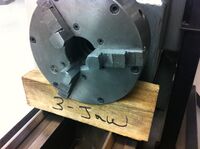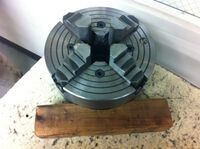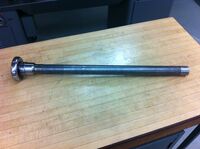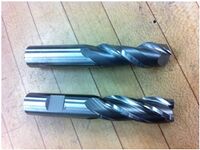Developers' Bulletin
11/12/13
Highlights: Page Names, Introduction to templates, Introduction to standards, Infobox standard, User accounts
IMPORTANT NOTICES
This bulletin applies to all fall/summer 2013 capstone design teams. All teams are required to conform to all parts of this bulletin!
Please also note, there have been two help pages added. Help:Standards (See below) and Help:Capstone_Design which gives guidelines for content and formatting.
Page Names
Unfortunately most page names need to be changed. See below guidelines for naming:
- page names should be the descriptive
- If the project has a descriptive name that can be refereed to in an acronym, spell out the name fully, then put the acronym in parenthesis
- Example: Security Enhanced Mobile Operating System (SEMOS) is a valid page name
- the name of your page should absolutely not be your team name.
- Example: FHSAE Voltz N Boltz is not acceptable
- names should be distinctive enough distinguish from other/previous projects.
- projects that are on-going (formula, snowmobile, tensegrity, etc.) need to be especially aware of this
- Do Not Camel Case You Page Name (unless part of acronym) - Instead capitalize the first letter in the name, as well as any nouns.
- make sure the name is descriptive enough to provide results from a search.
- check for pages that are similar in name, use dates, manufacture, type of application, etc to distinguish between two similar pages.
All names must be approved by your faculty adviser. Please get your name approved by Friday (11/15/2013) C.O.B. In order to change the name of you page you must:
- create a new page with the approved title
- copy all content from old page to new page
- delete content from old page
- add the following line of code to the old page:
#REDIRECT [[Your new page name]]
Introduction to templates
Templates are used to automatically to call wiki code and may include inputs. Templates ease development know-how, reduce time to build structured content, and provide an easy way to set up standard content. You will not be creating templates, only calling templates created by admins. If you need to create a template however, contact an admin and we would be glad to help! When multiple templates are used in this manner, they make up what is called a standard.
Templates are called by encompassing the template name in two sets of curly brackets:
{{TemplateName}}
Many templates can accept variables. Variables are separated by vertical pipes:
{{TemplateName|variableOne=foo|variableTwo=bar.jpg}}
It is as easy as that!
Introduction to standards
Standards is not a practice seen by other wikis, but the first admins contrived it in-order to help disseminate the information of new templates effectively and timely. A standards page will include:
- brief description
- example code of all templates used (convenient code to copy after you are familiar with the standard)
- table showing templateNames with descriptions and valid parameters
- example code of implementation
- result of example
- any special consideration needed for this template
For more information, see a full list of standards Help:Standards.
Infobox standard
All capstone design pages must include following table as the first lines of code. A final picture of your project will be included in this table, for now put a picture from snapshot. It is mandatory that all pictures be a 4:3 ratio.
| This table is meant to be used at the beginning of pages to convey to the reader important, repeatable information of a certain page type. See Special considerations below for entry requirements for various page types.
Applicable Templates{{InfoboxBegin
|name=AS5040
|image=EncoderOverviewLabled.jpg
|caption=An implementation of the AS5040 for keeping track of spindle position for the [[NASA Tensegrity]] senior design project of 2012
}}
{{InfoboxtEntry
|title = Device Type
|content = Encoder
}}
Usage
Example
{|{{InfoboxBegin
|name=AS5040
|image=EncoderOverviewLabled.jpg
|caption=An implementation of the AS5040 for keeping track of spindle position for the [[NASA Tensegrity]] senior design project of 2012
}}
{{InfoboxEntry
|title = Device Type
|content = Encoder
}}
{{InfoboxEntry
|title = Type
|content = Magnetic
}}
{{InfoboxEntry
|title = Manufacture
|content = [http://www.ams.com/eng Australia Microsystems (ams)]
}}
{{InfoboxEntry
|title = Model
|content = [http://www.ams.com/eng/Products/Magnetic-Position-Sensors/Rotary-Magnetic-Position-Sensors/AS5040 AS5040]
}}
{{InfoboxEntry
|title = Resolution
|content = 10 bit
}}
{{InfoboxEntry
|title = Modes
|content =
<ul>
<li>Absolute</li>
<li>Incremental</li>
<li>PWM</li>
</ul>
}}
{{InfoboxEntry
|title = Interfaces
|content =
<ul>
<li>SSI</li>
<li>PWM</li>
</ul>
}}
{{InfoboxEntry
|title = Max RPM
|content = 30,000 rpm
}}
|}
Special Considerations
| ||||||||||||||||||||||||||||||||
User accounts
All user accounts must be the prefix to your vandal email. No team name accounts are allowed. We are about to restrict the website to valid accounts only, so please adjust accordingly. We are enforcing this to help with the transition of the site from offsite to onsite hosting.
Sponsors
All teams need to list their sponsors (as links to their websites if applicable) in their infobox table. Remove sponsor sections and sponsor logos.
5/30/13
Highlights: Description guidelines, Checklist Table, Advantages/disadvantages table (ADtable), Kaizen page, Additional resources, How to check your page, Using a table to format your page
Page discussions
- Talk:Micrometer Measurements
- Talk:90_Degree_Mill_Head
- Talk:Swapping Lathe Chuck
- Talk:Cutter Types (Lathe)
- Talk:Cutter Types (Mill)
- Talk:Cleaning Machines
- Talk:Machine Setup/Maintenance (MakerBot)
- Talk:Code Generation (MakerBot)
- (pending) Talk:Part Design (MakerBot)
- Talk:Tramming Mill Head
- Talk:4th Axis (HAAS Mill)
- Talk:Mounting Tools (HAAS Mill)
- Talk:Squaring Rough Stock
Pages not (yet!!!) started
It is important that the first draft of these pages are started so we can give feedback.
Description guidelines
These pages do not have a proper description (the text directly under the page title):
- Swapping Lathe Chuck
- Cutter Types (Lathe)
- Cutter Types (Mill)
- Cleaning Machines
- Micrometer Measurements
For an example of a proper description see: Code Generation (MakerBot)
Guidelines for the page description has been reproduced for your convenience here:
All pages should include a short synopsis/description at the beginning directly under the page title. See any wikipedia page for an expample, or see Manual_Lathe. This section should also include:
- Any necessary 'Not to be confused with' statements (see code on Manual_Lathe for example of use of Distinguish template)
- Any necessary 'Skip to' statements (see code on Manual_Lathe for example)
- 'Main Article' statement (see code on Manual_Lathe for example of use of MainArticle template)
Checklist Table
| This table is meant to be used as a quick reference checklist and should be used for procedures that do not require lengthy details or photos.
Applicable Templates{| style="text-align: left;"
{{ChecklistCategory|title=Category1}}
{{ChecklistRow|title=step1}}
{{ChecklistRowDescription|title=Step2|description=description of step2}}
|}
Usage
Example
{| style="text-align: left;"
{{ChecklistCategory|title=Before Printing}}
{{ChecklistRowDescription|title=Secure machine|description=The printer must be on a stable work surface and must not able to rattle around. Add foam under the feet as necessary.}}
{{ChecklistRow|title=Turn on printer}}
{{ChecklistRowDescription|title=Check reel of filament|description=If empty/too low/wrong color, see (put link here)}}
{{ChecklistRowDescription|title=Preheat nozzle|description=ADD INSTRUCTION HERE}}
{{ChecklistRow|title=Insert SD card}}
{{ChecklistCategory|title=Starting the Job}}
{{ChecklistRowDescription|title=Begin job|description=ADD INSTRUCTION HERE}}
{{ChecklistRowDescription|title= Monitor first few layers|description=ADD INSTRUCTION HERE WITH LINK TO LEVELING BED}}
{{ChecklistCategory|title=Post Printing}}
{{ChecklistRowDescription|title=Remove part|description=ADD INSTRUCTION HERE}}
{{ChecklistRowDescription|title=Cool extruder|description=ADD INSTRUCTION HERE}}
{{ChecklistRowDescription|title=Clean printer|description=ADD INSTRUCTION HERE}}
{{ChecklistRowDescription|title=Turn of printer|description=After the fan has shut off, cooling has completed and the printer may be turned off}}
|}
Special ConsiderationsNone |
Advantages/disadvantages table (ADtable)
{|class="wikitable"
|+Caption
!Item!!Advantages!!Disadvantages
|-
{{ADRow|fileName=name.JPG|caption=picture caption|advantages=list of items|disadvantages=list of items}}
|}
This is a table used for comparing and contrasting multiple items. Usage
Example
{|class="wikitable"
|+Advantages and disadvantages of various types of lathe chucks
!Chuck!!Advantages!!Disadvantages
|-
{{ADRow|fileName=Block_Under_Chuck.JPG|caption=Three jaw chuck|advantages=
<ul>
<li>Self-centering</li>
<li>Can hold hex bar-stock</li>
<li>Quick and easy to use</li>
</ul>
|disadvantages=
<ul>
<li>Can't hold square bar-stock</li>
<li>Run-out/off-center can't be easily fixed</li>
<li>Can't hold irregularly shaped work</li>
<li>Can't turn off-center</li>
</ul>}}
{{ADRow|fileName=4 Jaw Chuck.JPG|caption=Four jaw chuck|advantages=
<ul>
<li>Work can be centered to high precision</li>
<li>Can handle square/rectangular bar</li>
<li>Can turn work off-center</li>
<li>Slightly more grip on round stock</li>
</ul>
|disadvantages=
<ul>
<li>Slower/fiddlier to mount work (dial-indicator required)</li>
<li>Can't hold hex-stock</li>
</ul>}}
{{ADRow|fileName=Cullet Chuck.JPG|caption=Collet chuck|advantages=
<ul>
<li>Coffee</li>
<li>Milk</li>
</ul>
|disadvantages=
<ul>
<li>Coffee</li>
<li>Milk</li>
</ul>}}
|}
Special ConsiderationsThe normal wiki markup ofr bulleted list does not display properly. Use HTML markup instead
|
Kaizen suggestion page
We now have a page where anyone can add their own ideas for Kaizen projects
Additional resources
When creating these pages it is important not to reinvent the wheel (no value added in reinventing the wheel). We brought this up because there are several resources which exist that should be checked by each Kaizen project:
- Shop Binder
- Legacy Mindworks website
- Machinist handbook
All teams should check these sources to ensure complete content. A table of contents of the chop binder has been posted here for your convenience.
| Item | Page No. |
|---|---|
| Items in shop and cabinet locations | 1 |
| 1-2-3 blocks | 5 |
| Boring Head | 6 |
| Center Drills | 8 |
| Chamfer Tools | 9 |
| Collet Blocks | 10 |
| Corner Rounding End Mills | 11 |
| Counterbores | 12 |
| Countersinks | 13 |
| Deburring Tools | 14 |
| Drill Bits | 15 |
| End Mills | 16 |
| End Mill Sizes in the Shop | 17 |
| How to Tram a Mill Head | 18 |
| Inside Micrometer | 30 |
| Jack Screws | 31 |
| Live Centers | 32 |
| Mig Welding | 33 |
| Morse Taper Drills | 43 |
| Reamers | 47 |
| Right Angle Head | 49 |
| Sine Bar | 50 |
| Step Drills | 52 |
| Taps | 53 |
| Telescoping Hole Gages | 56 |
| Thread Gages | 57 |
| Tig Welding | 58 |
| Transfer Punches | 71 |
| T-Slot Cutters | 72 |
How to check your page
- Have another group read over your pages
- Make sure to print out a copy of your page (or view it on your phone) and explicitly follow your steps
- Review the content with Russ
- Review your page with Curtis or Alex
You are not done until you have completed above steps
Using a table to format your page
Sometimes it is nice to control how the pictures and tables are laid out in your page. This can be accomplished with tables. The most basic table (without a class callout) will default to use 100% of the page, which means you can make a table with one row and two columns to help with formatting. You can also use a table with multiple rows and one column, where each cell has an entire section. If there is anything specific you would like to know, just email Curtis or Alex.
Some good examples:
5/28/13
Highlights:Uploading videos, Guidelines for Pictures/Figures, Itemized/Step by step table, Description guidelines
Q&A
There was a question regarding uploading videos. Please see Help:Page Editing (Quick) for more information.
Page discussions
We went through and added comments to many of the pages, including:
Please incorporate comments by tomorrow midday.
Tomorrow I will be adding comments to:
- 90 Degree Mill Head
- Part Design (MakerBot)
- Code Generation (MakerBot)
- Machine Setup/Maintenance (MakerBot)
Pages not started
- Tramming Mill Head
- 4th Axis (HAAS Mill)
- Mounting Tools (HAAS Mill)
- Squaring Rough Stock
- Micrometer Measurements
- Tumbler (C&M Topline)
- Boring Head
- Broach
- Sine Bar
- Rotary Table
Guidelines for Pictures/Figures
- Figures and drawings are far superior than pictures and should be used when reasonable
- Mismatching of figures and images should be avoided
- Figures should approach McMaster quality of figures see: http://www.mcmaster.com/#end-mills/=mycaju
- Figures can be created in gimp, inkscape, SW or you choice of software
- If pictures are required:
- Try to make the group of pictures consistent. For example, the example table below has endmills laying down, and one standing up. This is bad practice!!!
- Groups of images (pictures or figures) should have the same aspect ratio, and when possible should be of 1.33:1 (or 4:3). see: http://en.wikipedia.org/wiki/Aspect_ratio_(image)#4:3_standard
- Use consistent backgrounds, and when possible white background (piece of printer paper works well). This allows for easy future editing of image like background removal through gimp or photoshop.
Itemized/Step by step table (ID Table)
{| class="wikitable" style="text-align: left;"
|+ style="text-align: left;"| Caption
! style="text-align: left;"|Tool/Step!!style="text-align: left;"|Description
|-
| {{RowPicture|fileName=name.jpg|caption=End Mill|description=add description here}}
|}
This table is used to provide information that is itemized/Step by step. Usage
Example
<pre style="white-space: pre-wrap;
white-space: -moz-pre-wrap;
white-space: -pre-wrap;
white-space: -o-pre-wrap;
word-wrap: break-word;">
{| class="wikitable" style="text-align: left;"
|+ style="text-align: left;"| Various types of mill cutters:
! style="text-align: left;"|Tool/Step!!style="text-align: left;"|Description
|-
| {{RowPicture|fileName=Mill end.jpg|caption=End Mill|description=An endmill is a type of milling cutter, a cutting tool used in industrial milling applications. It is distinguished from the drill bit in its application, geometry, and manufacture. While a drill bit can only cut in the axial direction, a milling bit can generally cut in all directions, though some cannot cut axially. End mills are used in milling applications such as profile milling, tracer milling, face milling, and plunging.}}
|-
| {{RowPicture|fileName=Mill end Rough.jpg|caption=6 Flute End Mill|description=This is NOT a roughing end mill}}
|}
Special ConsiderationsNone |
Simply copy and paste the code as required. Lines 1,2,3 set up the table, remember to change the table caption (Various types of mill cutters:) and the table headers (Tool/Step and Description). Copy and paste the 6th and 7th row as needed to add rows to the table, remembering to change the fileName, caption, and description fields as needed. The 5th row is an example and may be deleted. If the table is used for 'step by step' procedures, format caption as the following: Step 1: Turn on the Machine.
- About this table
- This table uses a template named we created RowPicture which is called by using double brackets {{TemplateName}}. The template requires the necessary syntax to finish the row of the table.
Description guidelines
All pages should include a short synopsis/description at the beginning directly under the page title. See any wikipedia page for an expample, or see Manual_Lathe. This section should also include:
- Any necessary 'Not to be confused with' statements (see code on Manual_Lathe for example of use of Distinguish template)
- Any necessary 'Skip to' statements (see code on Manual_Lathe for example)
- 'Main Article' statement (see code on Manual_Lathe for example of use of MainArticle template)





